VBASE Oil Company
VBASE® Base Oils: A New Class of High-Performance, Environmentally Friendly Fluids
By Zach Hunt | TLT CMF Plus November 2022
Designed to provide formulators with hydrolytically stable, high performance base oils which are also environmentally friendly, VBASE® Oil Company has commercialized a new class of API Group V base oils built with Secondary Polyol Ester™ (SPE) chemistry. Developed specifically in response to environmental and sustainability concerns surrounding petroleum-based oils, VBASE® base oils are all NSF HX-1 certified, biobased, biodegradable, non-toxic, and non-bioaccumulating. The versatile chemistry of the SPE™ technology allows these base oils across a wide range of viscosity grades. Currently, ISO VG 32-100 with an expansion to ISO 680 in 2023. With exceptional lubricating performance, the VBASE® oils are ideal for use in a range of applications such as transmission oils, greases, gear oils, compressor oils, universal tractor fluids, hydraulic oils, wind turbine oils, and hydropower turbine oils.
How do VBASE® Base Oils Compare to Traditional Group V Oils?
While esters tend to provide excellent lubricity as a base oil, there are many other properties that must be taken into account when selecting a base oil. Natural esters (e.g., vegetable oils) have practical limitations because of poor cold weather performance, poor thermo-oxidative and hydrolytic stability, and poor compatibility with some seals and gaskets. Synthetic esters have been designed to overcome challenges with pour points and oxidative stability, but still have shortcomings with seal and paint compatibility and hydrolytic stability. Even the neopolyol esters, commonly regarded as some of the highest performing lubricants on the market, suffer from poor hydrolytic stability. Moreover, many synthetic esters are manufactured from non-renewable petrochemical feedstocks.
Polyalkylene glycol (PAG) base oils are a hydrolytically stable alternative Group V oil which also provides exceptional lubricity; however, they have their own notable shortcomings. PAGs exhibit limited seal and paint compatibility, and more significantly, traditional ethylene/propylene oxide derived PAGs lack miscibility with mineral oils which presents a barrier to transitioning equipment from a mineral oil to a synthetic PAG-based lubricant. PAG miscibility issues can be mitigated by utilizing newer oil soluble PAGs, but these are only available at a more expensive price point.
VBASE® base oils address the shortcomings of traditional esters with superior hydrolytic stability derived from its Secondary Polyol Ester™ technology. Further, VBASE® base oils provide excellent solvency and fluid miscibility in hydrocarbon oils without sacrificing elastomer and coating compatibility. These attributes, coupled with excellent viscosity indices and low-temperature performance, along with NSF HX-1 and LuSC-List certifications make VBASE base oils an ideal choice in formulating modern environmentally acceptable lubricants.
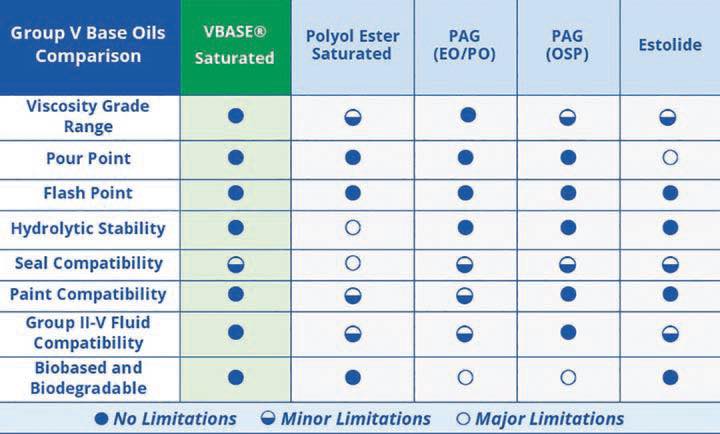 Table 1: Comparison of API Group V Oils
How are Secondary Polyol Esters™ Different From Traditional Polyol Esters?
Table 1: Comparison of API Group V Oils
How are Secondary Polyol Esters™ Different From Traditional Polyol Esters?
Neo-polyol esters are produced by reacting polyols (e.g., neopentyl glycol, trimethylolpropane or pentaerythritol), molecules that have two or more hydroxyl groups, with fatty acids to form an ester. Traditional polyol esters (including natural seed oil) use polyols which have hydroxyl groups that are “primary hydroxyls.” “Primary” meaning that the hydroxyl is at the end of a carbon chain. The reaction of a primary hydroxyl with a fatty acid produces a primary ester. VBASE® base oils are produced with a secondary ester, where the ester bond is branched off a chain of carbon atoms, not at the end of a carbon chain.
Figures 1 and 2 show an example structural representation of a primary ester and a secondary ester, respectively. While the only difference in
Figures 1 and 2 is the addition of a methyl group (the CH3 group) in
Figure 2, the performance increase is substantial.
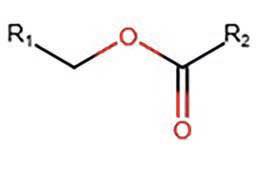 Figure 1: Structural representation of a primary polyol ester.
Figure 1: Structural representation of a primary polyol ester.
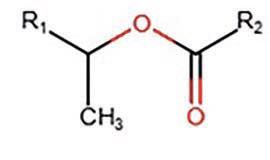
Figure 2: Structural representation of a type of secondary polyol ester.
Functional Performance of VBASE® Base Oils
The branching of the SPE™ significantly influences the hydrolytic and thermal stability of the oil, as evidenced by performance on the ASTM D2619 hydrolytic stability test and the ASTM D2070 thermal stability test. Under both test protocols, the VBASE® base oils display negligible varnish formation, minimal viscosity change, and minimal change to both steel and copper catalysts. Hydrolytic stability is one of the biggest issues in the use of any ester where there is the potential for water contact. The branching incorporated in the VBASE® molecule creates a steric hindrance that makes it difficult for a water molecule to get close enough to the ester bond to react and reduce oil performance.
Additionally, the branching in the SPE™ functionality reduces the pour point of the oil (the cold temperature at which oil viscosity increases to the point it will no longer pour). Because of this structural feature, VBASE® base oils can utilize saturated fatty acids without sacrificing cold temperature performance
(Table 2). Saturated acids also further enhance the thermal stability and varnish resistance of VBASE® base oils. Generally, to achieve acceptable cold temperature performance, natural oil lubricants must consist primarily of unsaturated fatty acid esters; however, the double bonds of the unsaturated fatty acids are prone to oxidation. This oxidation can result in deposit formation, varnishing, and a significant viscosity increase of the lubricant. Neo-polyol esters can utilize short chain saturated acids to avoid these issues, but the high stability saturated esters have a limited viscosity range (ISO VG 46 and below).
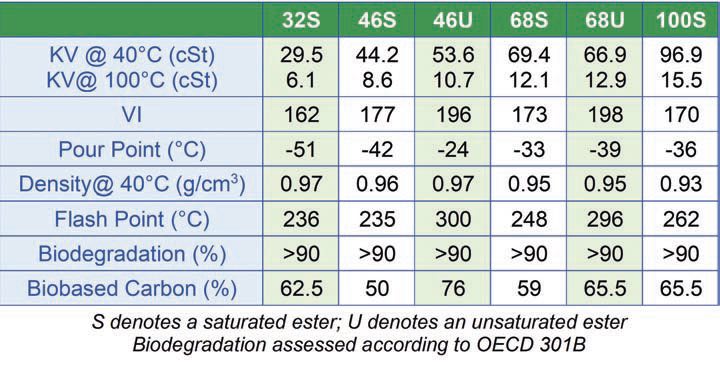 Table 2: Physical Properties of VBASE Base Oils
Table 2: Physical Properties of VBASE Base Oils
One final, but very important characteristic of VBASE® base oils resulting from the molecular structure is the high level of material compatibility with the seals/gaskets, existing oil, and coatings/paints in equipment. Operators and asset owners are resistant to making the switch from petroleum-based oils to biobased synthetic esters because of their historically poor compatibility with existing seals and gaskets in equipment not designed for ester-based oils. However, when compared to commercial polyol esters, VBASE® base oils show excellent compatibility with seals and gaskets
(Figures 3 and 4).
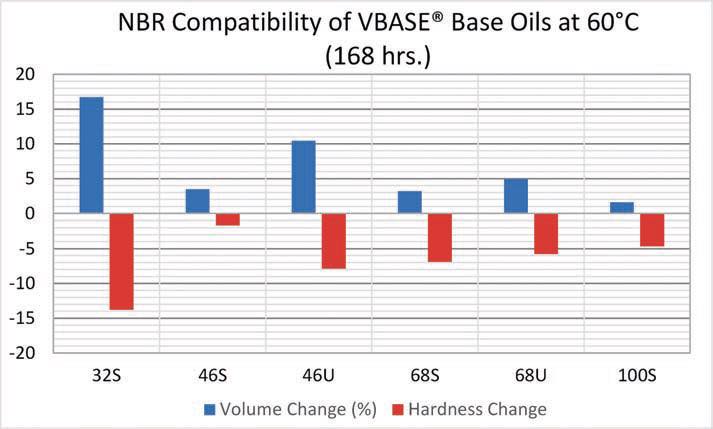 Figure 3: Volume and hardness change results for NBR coupons immersed in VBASE base oils.
Figure 3: Volume and hardness change results for NBR coupons immersed in VBASE base oils.
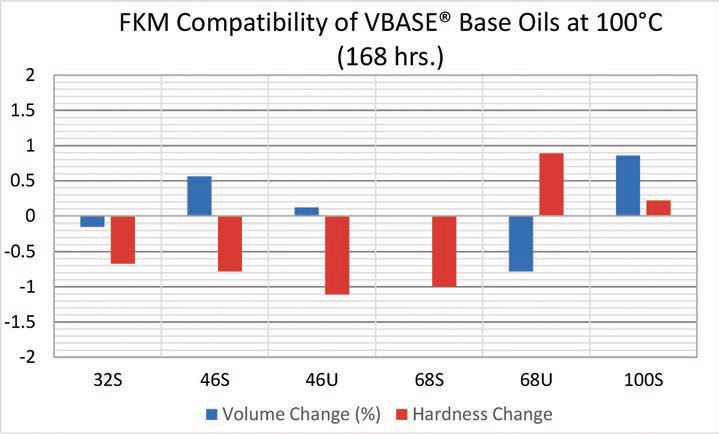
Figure 4: Volume and hardness change results for FKM coupons immersed in VBASE base oils.
VBASE® base oils are compatible with API Group II-V base oils at a 50:50 (v:v) ratio. Paint compatibility with VBASE® SPE™ base oils was verified using Caterpillar Fluid Immersion Resistance Testing: Caterpillar 1E1952 [500hrs. at 25±2°C] and John Deere Fluid Resistance Testing: John Deere JDM F17 [24hrs. at 23±3°C]. Testing under both protocols saw no blistering, discoloration, delamination, or corrosion. The overall material compatibility of VBASE® base oils set them apart from all other API Group V base oils.
Base Oils for Sustainable Solutions
In addition to secondary polyol ester chemistry, VBASE® base oils have been optimized with proprietary chemistry for long-term performance in equipment while maintaining its status as “readily biodegradable” with up to 95% degradation over 28 days in the environment.
VBASE® base oils have been carefully designed to offer superior stability, broad compatibility, and maximum performance across a wide viscosity range in a non-toxic, biobased, and biodegradable platform. By utilizing VBASE® base oils in their formulations, blenders can now reduce their carbon footprint and meet sustainability goals while improving performance without compromise.
